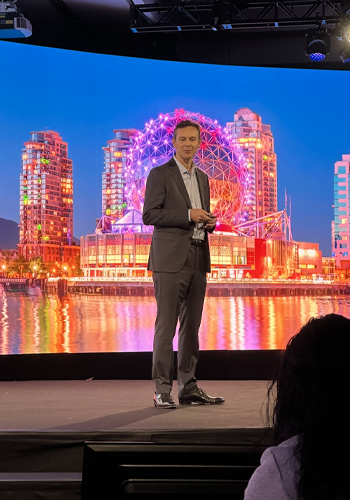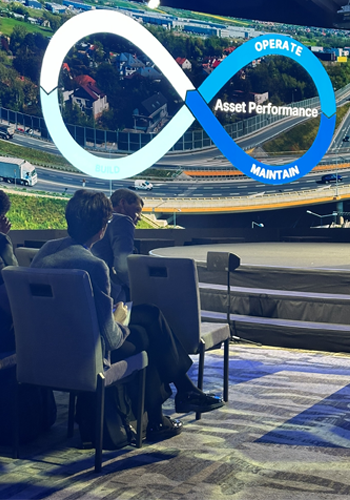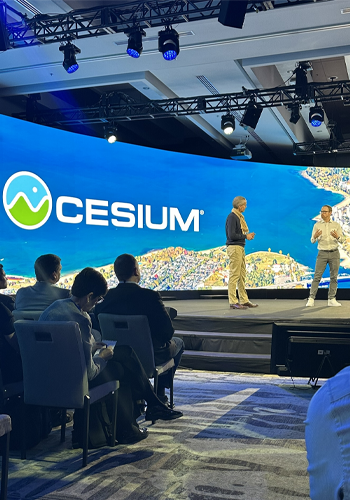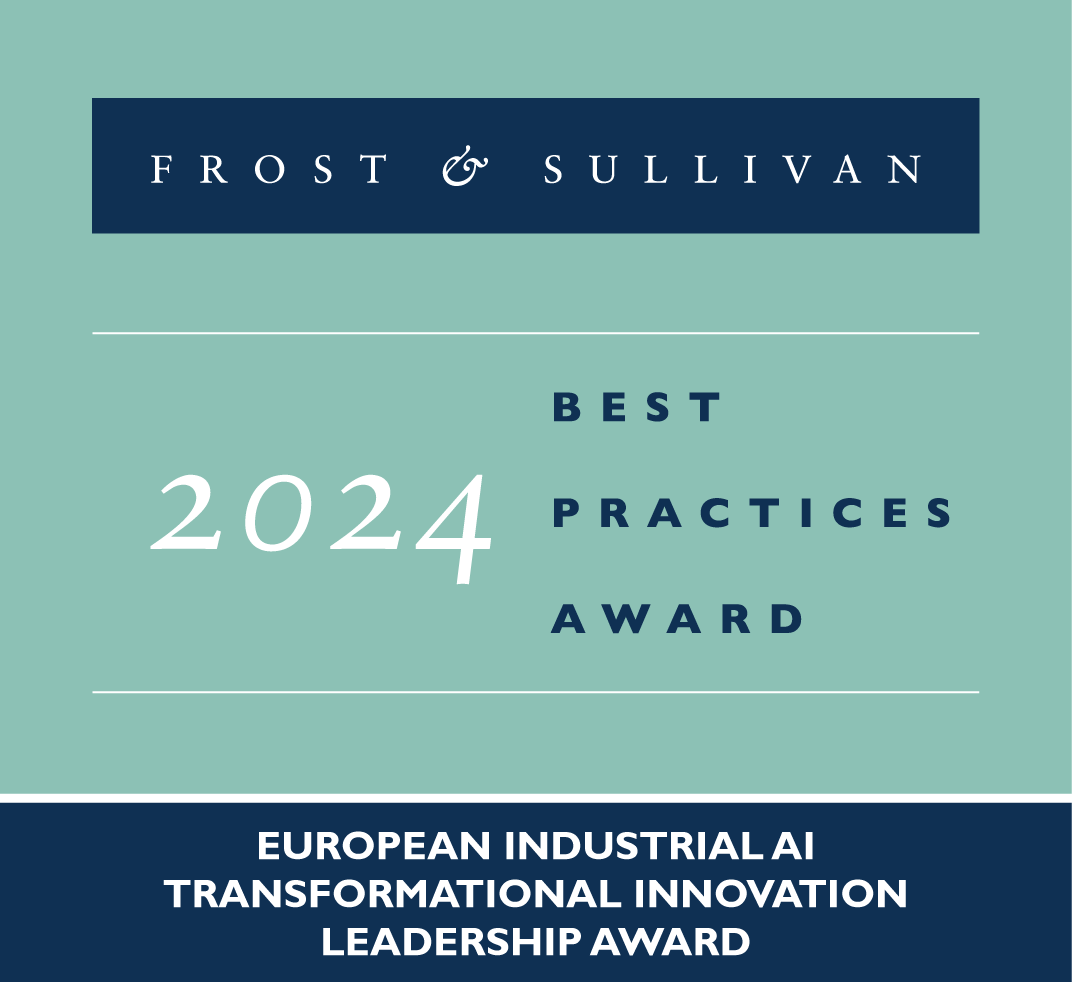By Krishna Achuthan, Research Manager – Mobility
Bentley Systems, a global leader in infrastructure engineering software, hosted its annual Year in Infrastructure (YII) 2024 event in Vancouver, Canada, on October 8-9, 2024. As an attendee at this two-day event, I had an up-close view of industry leaders showcasing new technologies, emerging trends, and innovative ideas for the future.
A major highlight was the “Going Digital” Awards, which recognized organizations excelling in advancing global infrastructure. Thirty-six finalists from twelve different sectors shared key project insights, success metrics, and, most importantly, how their collaboration with Bentley Systems and its engineering solutions helped them achieve their project goals. The sectors represented included Bridges and Tunnels, Construction, Campuses and Cities, Rail & Transit, Roads & Highways, and Structural Engineering, among others. A designated panel of jurors evaluated each of the award finalists before selecting the eventual winners in each category.
CEO Address: ‘Sustaining Tomorrow’s Infrastructure’

On October 9th, the Year In Infrastructure (YII) 2024 kicked off with a keynote from Bentley Systems CEO Nicholas Cumins. He discussed how Bentley Systems recognized the potential of personal computers in 1984, driving a paradigm shift in engineering software, starting from CAD to Microstation. He outlined the company’s advancements from web-based solutions to 4D construction modeling and how Bentley pushed boundaries further with Digital Twins, allowing engineers to monitor, manage, and optimize real-world data through dynamic replicas. Now, after 40 years of innovation, Bentley is focusing on artificial intelligence (AI) to fuel another transformation.
Cumins highlighted how AI can enhance efficiency in projects like road maintenance by minimizing disruptions and automating repetitive tasks. He also pointed out the challenges in resource and data management—there is no shortage of demand or data, but there is a lack of engineers and actionable insights. He emphasized that 95% of the infrastructure we will use in 2030 already exists today, putting immense pressure on making current systems more resilient and efficient to meet future demands.
To address these challenges, Cumins showcased three key projects from the Going Digital Awards: the Bridging Kentucky Program by QK4, Inc., Ohio Falls River Crossing Towers by Exo Inc., and Singapore’s Public Utilities Board’s Smart Water Grid Program. He then introduced Bentley Systems’ forward-looking strategy: combining products, innovations, and acquisitions into a new portfolio—Bentley Asset Analytics. This AI-driven solution will generate insights on existing infrastructure assets, enabling broader collaboration with engineering firms.
Since acquiring Cesium, Bentley has expanded its 3D geospatial capabilities, enhancing asset accuracy to the millimeter level. The shared focus on interoperability and open-source solutions led Cumins to highlight the importance of Open Data Ecosystems, which optimize data sharing and efficiency across vendors. Over the last decade, Bentley has developed an open-source infrastructure schema to help stakeholders better leverage data. Cumins also announced a new strategic partnership with Google, aiming to combine Google’s geospatial data with Bentley’s infrastructure expertise to deliver more comprehensive and actionable insights for sustainable infrastructure development.
Technology and Product Keynote: ‘Making the Right Connections’
The next session featured Julien Moutte, Chief Technology Officer, and Mike Campbell, Chief Product Officer. They provided technology updates, including digital twin technologies designed to connect data, workflows, and professionals, and highlighted Cesium’s role in the company’s solutions portfolio. Cesium’s integration with Bentley’s offerings was explored by Cesium’s founder, now Bentley’s Chief Platform Officer, Patrick Cozzi, who underlined the benefits of 3D tiles and their adoption by open geospatial consortiums.
Yael Maguire, Google’s Vice President and GM of Google Maps Platform and Geo Sustainability, discussed Google’s capabilities in geo-sustainability and its collaboration with Bentley Systems. Maguire explained that petabytes of publicly accessible data are helping businesses, developers, and cities make better use of these resources. Maguire emphasized the use of 3D tiles, an open standard developed with Cesium, which has been integrated into several Google products. This photorealistic 3D tile format is used in Google Earth and was adopted by the Open Geospatial Consortium, created by Cesium. This standard has fueled rapid innovation and product development, with Cesium-powered 3D imagery now covering over 2,500 cities in 49 countries.
New Product Launches
The product launches were introduced by Mike Campbell, who emphasized the need to make the right connections in infrastructure engineering. He highlighted that infrastructure systems are often complex and disconnected, making it crucial to connect both people and data to meet the growing demands of infrastructure and population growth. Campbell explained that Bentley has addressed this challenge through the Infrastructure Digital Twin (iTwin). He stressed the importance of data openness, noting that with many databases scattered across different systems and tools, integration is key—iTwin helps achieve this without duplicating data. Accessibility is another critical factor, as workflows that create and manage data through iTwin must be intuitive and transparent to integrate seamlessly with processes. This is why Bentley focuses on making applications iTwin-native, supporting data-centric workflows effectively.
- Open Site+
Open Site+ was introduced by Francois Valois, Vice President of Civil Engineering at Bentley Systems, and Joseph Viscuso, Senior Vice President and Director of Strategic Growth at Pennoni. This next-generation product, built around digital twins and generative AI, offers advanced features like copilot-assisted experiences, site layout optimization, and automated drawing production.
During a live demonstration, they showcased Open Site+ with a hotel construction project. The built-in Copilot utilizes the organization’s existing files to provide answers to design questions. For example, when Valois asked, “Can I build a hotel in this area?” the Copilot not only gave an answer but also provided links to the relevant documents, helping the engineer trace the source. Valois further demonstrated how the Copilot handles complex queries, such as determining the required parking for a 200-room hotel and whether it can fit in the space available. The Copilot analyzes thousands of alternatives to find the best option, balancing cost and engineering requirements.
In addition to these capabilities, the Copilot can modify designs. Other standout features of Open Site+ include AI-powered optimization for site grading, simplified stormwater management, and perhaps most notably, AI-driven drawing optimization and production. This makes Open Site+ a powerful tool that leverages natural language input for streamlined design processes.
- Microstation
Powered by the iTwin platform, Microstation 2024 equips infrastructure professionals to design at scale and in context. Key features include digital twin integration, real-time geospatial insights to enhance design, and ad-hoc collaboration. The product was unveiled by Susanne Trierscheid, Vice President of Modeling and Facilities Engineering at Bentley Systems. Microstation 2024 streamlines workflows by merging desktop functionality with iTwin cloud services across Bentley’s open applications. Enhanced GIS integration, Python scripting support, and iTwin-enabled collaboration are the three standout features Trierscheid emphasized, improving project workflows of all sizes from the start.
- Bentley Asset Analytics
In the next segment, the focus shifted from design and engineering to the operations phase. Campbell highlighted Bentley Asset Analytics, which combines existing products, new innovations, and recent acquisitions to ensure assets remain safe, reliable, and resilient. Mike Schelhase, Vice President of Asset Analytics at Bentley, introduced Blyncsy, a roadway insights platform that uses crowd-sourced data and machine learning models. Blyncsy leverages AI to detect issues like broken stop signs or faulty streetlights, cutting inspection times by 90% and allowing technicians to focus on repairs. The platform is currently in use by the City of Fort Worth, Texas, and the Alaska Department of Transportation.
In addition to Blyncsy, Open Tower iQ was introduced, which automates cell tower lifecycle management using AI and drone imagery to identify and address problems. Over the past year, Bentley has used iTwin to automate inventory and equipment detection for over 25,000 towers—17% of the total in the U.S.—and with growing demand, Open Tower iQ is expected to see increased adoption.
- Bentley Infrastructure Cloud
The Bentley Infrastructure Cloud, built on the iTwin platform, enhances enterprise solutions by seamlessly connecting project and asset information management. Chris Bradshaw, Bentley’s Chief Sustainability Officer, explained how the Bentley Infrastructure Cloud plays a vital role in advancing sustainability efforts.
Campbell delved deeper into the capabilities of the Bentley Infrastructure Cloud. Oliver Conze, Senior Vice President of Bentley Infrastructure Cloud Systems, discussed how the Bentley Infrastructure Cloud is evolving to eliminate barriers, enabling seamless information exchange through a data-centric approach powered by digital twins. This fosters continuous collaboration, leading to faster decision-making and improved outcomes. He highlighted the integrated Design Build project launched last month, which unites ProjectWise and Synchro within the Bentley Infrastructure Cloud, enhancing deliverables management alongside 3D planning and scheduling. He also emphasized the integration of 2D and 3D sheets within the platform. Next, he introduced a mobile app that allows users to enhance models with real-time insights on-site, helping to quickly resolve issues even in areas with poor internet connectivity through offline mode.
- Carbon Analysis
Bradshaw, alongside Kelvin Saldanha, Associate Director at WSP, introduced a new feature—Carbon Analysis. Saldanha outlined the key challenges of calculating embodied carbon, primarily the inconsistency due to the use of multiple tools, which often results in carbon scores feeling imprecise. The process can involve data cleansing and using various tools, making it difficult to calculate an accurate score, while also consuming significant time.
The iTwin Carbon Analysis tool addresses these issues by offering unprecedented transparency. It enables the design team to calculate carbon scores much earlier in the project lifecycle, with instant reporting. Updating the design model immediately reflects the carbon footprint, reducing the feedback loop from weeks to just days. One of the standout features is its ability to generate carbon heat maps, allowing users to visualize carbon intensity and target specific areas for improvement. A demonstration followed, and Bradshaw concluded by announcing that the Carbon Analysis feature is now available in iTwin at no additional cost.
- Advanced Visualization Tool
Campbell then announced an advanced visualization capability aimed at creating immersive, photo-realistic infrastructure experiences using Epic Games’ Unreal Engine. Greg Demchak, Vice President of Emerging Technologies at Bentley, provided further details on this tool. He explained the challenges associated with current visualization tools, which can be cumbersome and often require extensive rework for material, lighting, and rendering. The new Advanced Visualization tool reinvents the visualization pipeline, being purpose-built for high performance and immersion. Utilizing open-standard Cesium 3D tiles, it enables users to explore and experience digital twins in real-time with no delays, allowing for instant sharing of visualizations with stakeholders.
A demonstration showcased the Bull Run Filtration project from Bentley’s iLab, set up in a conference room in Vancouver. Jeffrey Campbell, Director of Virtual Planning at Project Controls Cubed, guided attendees through the Portland Water Bureau’s project, highlighting how AI can generate keywords and phrases as tangible objects in the infrastructure. This concluded the product announcement session.
Cesium’s Journey to Infrastructure
Patrick Cozzi, Founder and Chief Platform Officer at Cesium shared the journey of Cesium since its inception in 2011. He detailed how it has evolved to offer a blend of open-source and commercially available software for building 3D geospatial applications. Cozzi highlighted key Cesium projects, including the digital twin project of the X-Alps paragliding race, collaborations with Komatsu for smart construction in mining, and partnerships with NBC Sports for the Paris Summer Games.
The day’s final session before industry breakout sessions featured guest speaker Deb Chachra, author of “How Infrastructure Works.” She provided insights into how cities have developed their infrastructure over the years and stressed the importance of preserving ethical considerations in this process.
Conclusion
Bentley Systems Year in Infrastructure 2024 was replete with insights into the future of infrastructure engineering. The event showcased cutting-edge technologies, including AI, digital twins, and advanced visualization tools. The event closed with the Going Digital Awards where winners from 36 award finalists across 12 different sectors were announced. All in all, it was a power-packed event showcasing advances in infrastructure advances and future-focused ideas, overarched by an emphasis on innovation, sustainability, and collaboration for a better tomorrow.
With inputs from Amrita Shetty, Senior Manager, Communications & Content – Mobility






